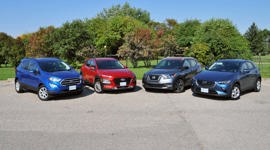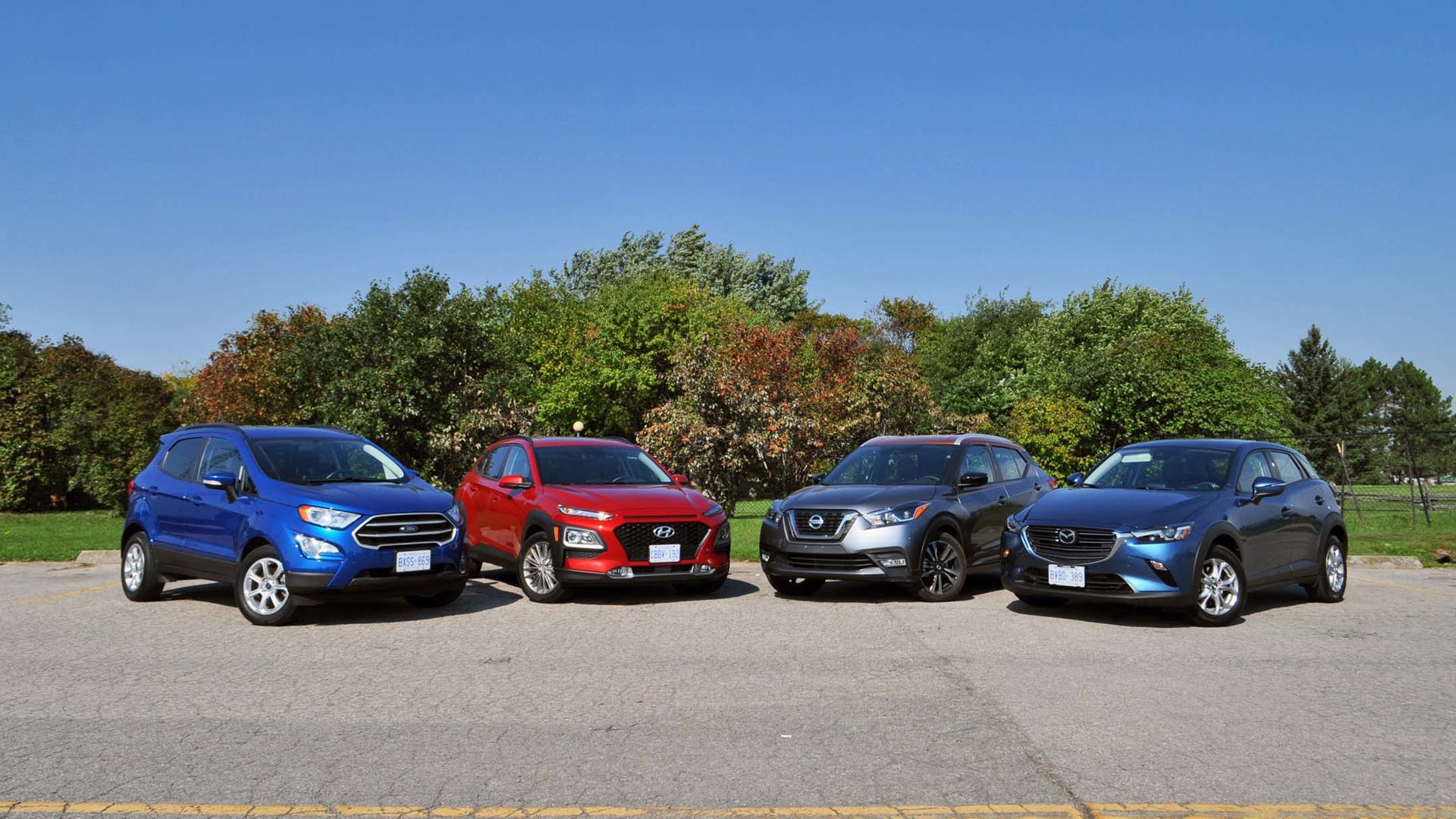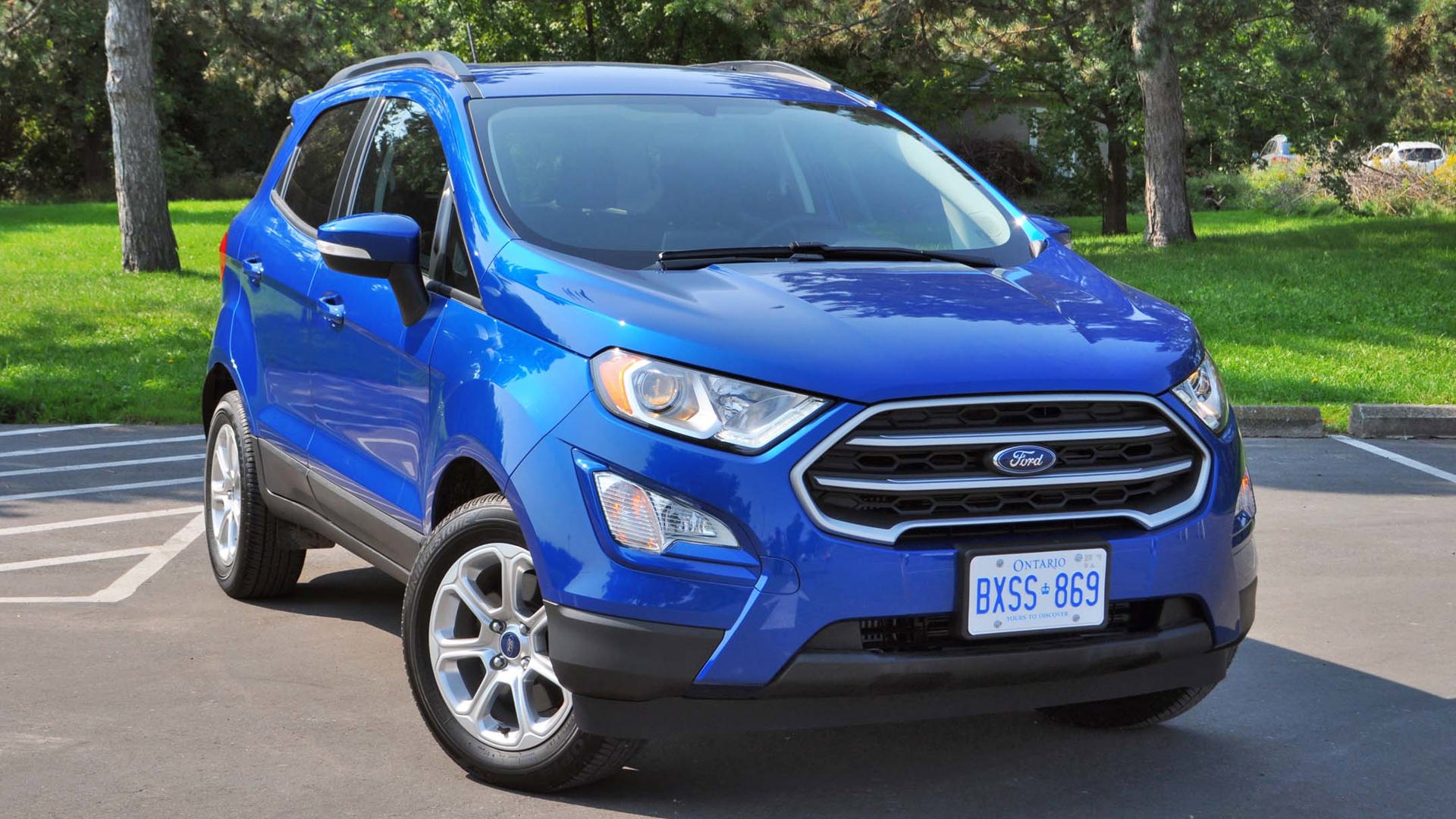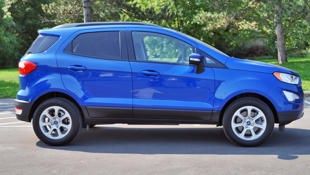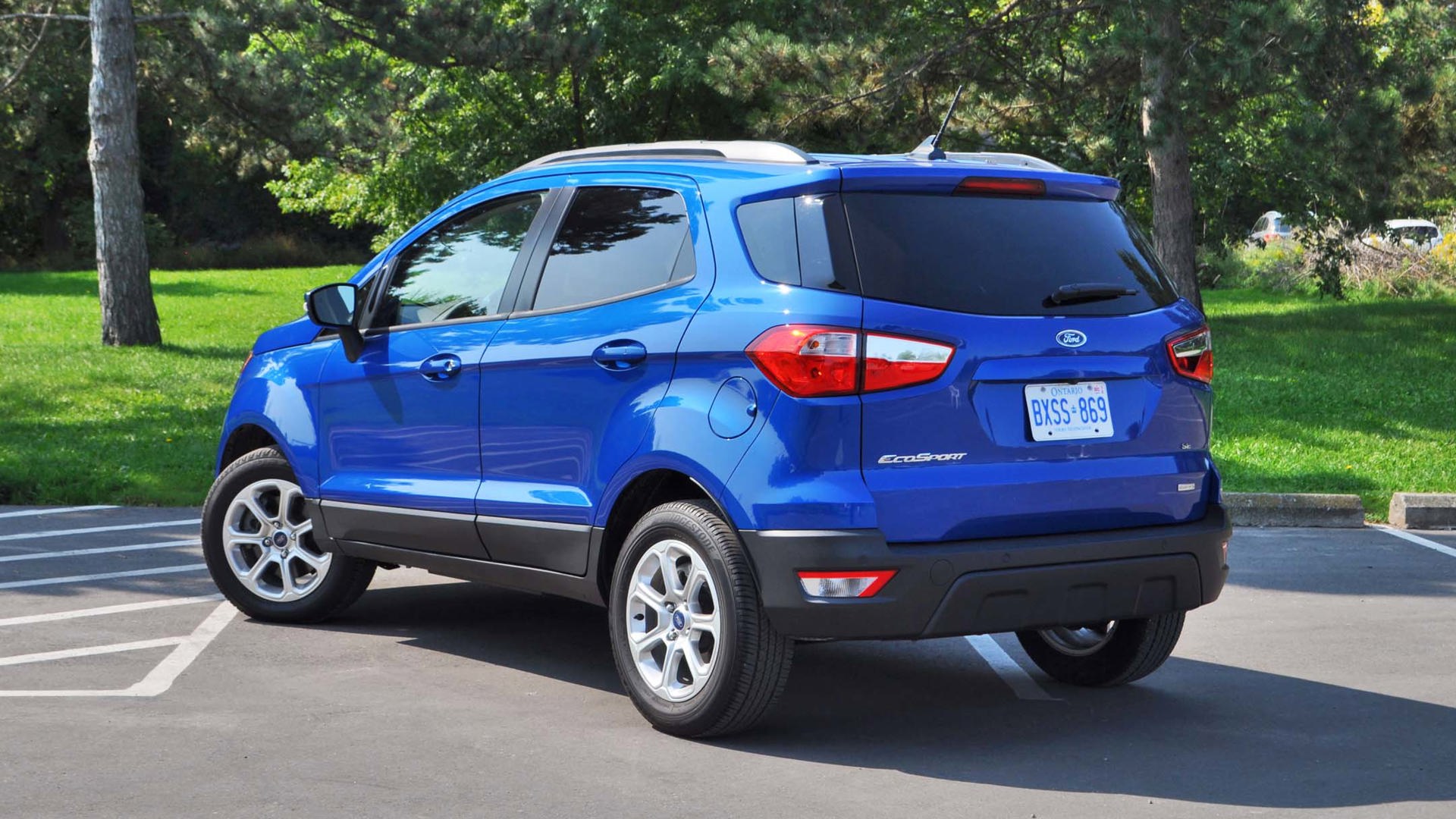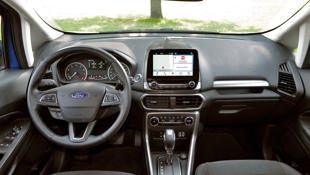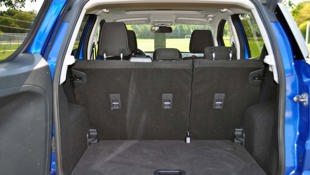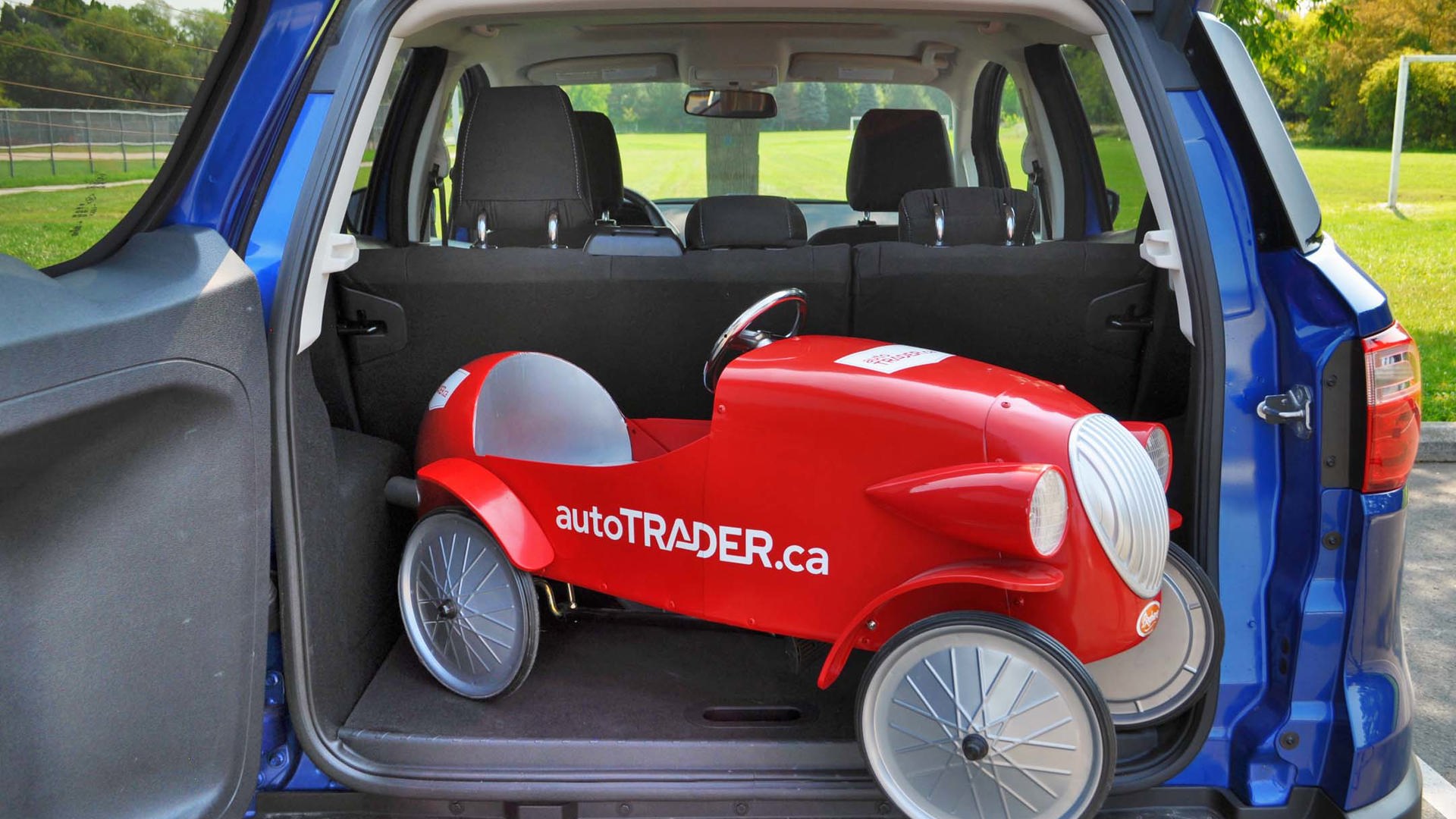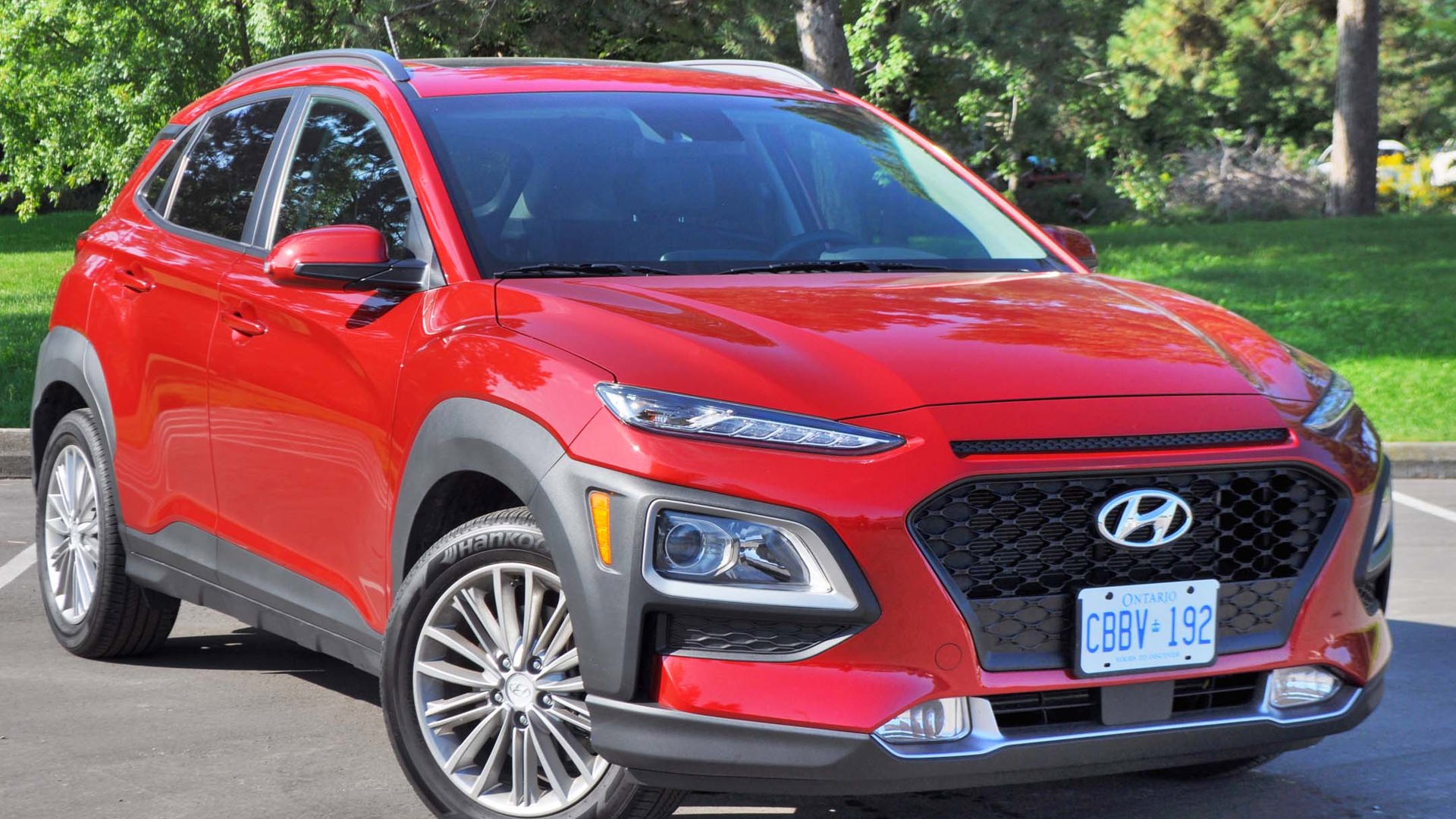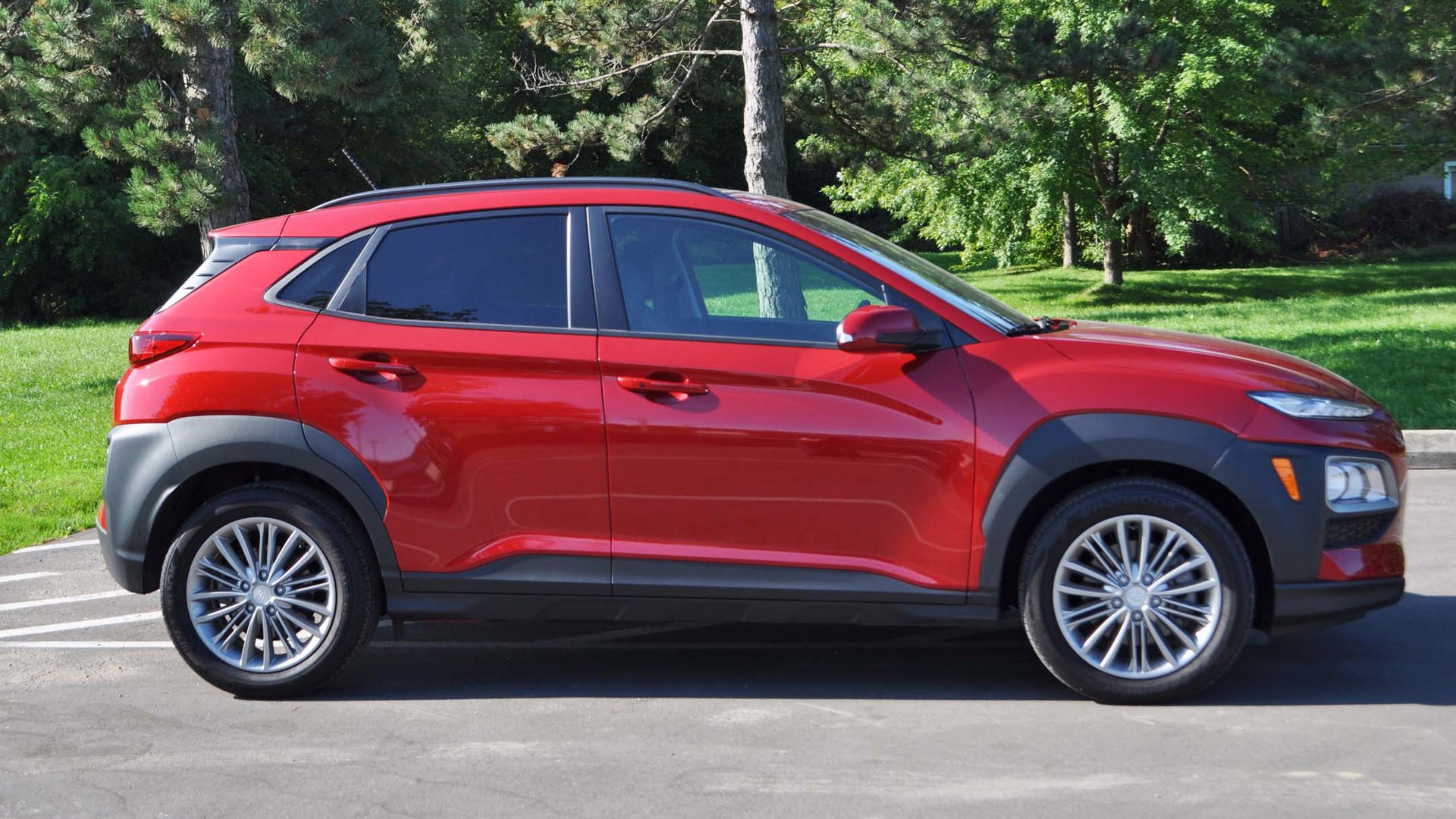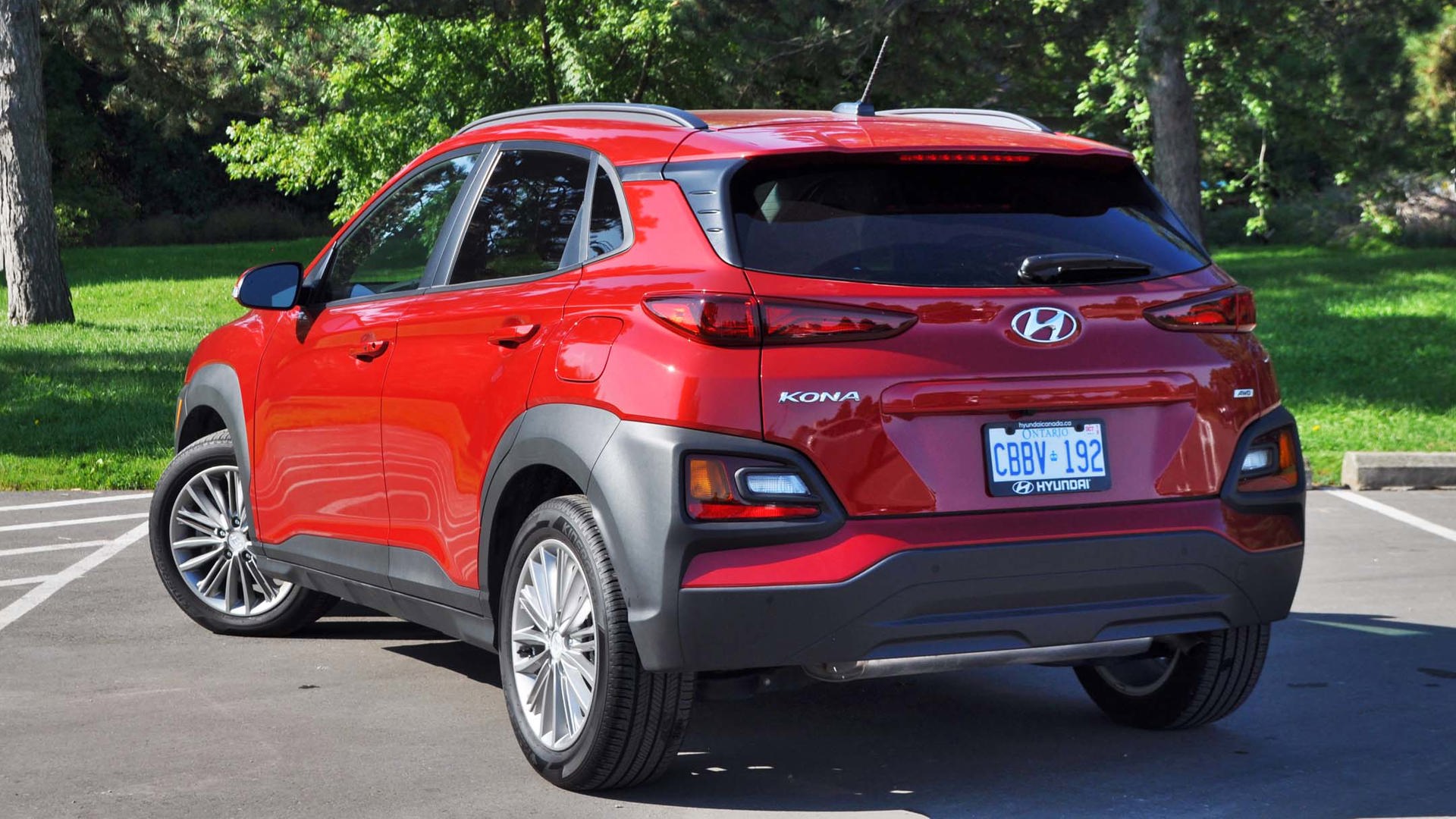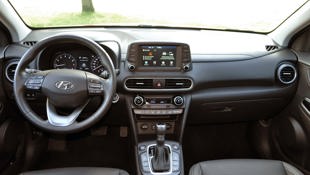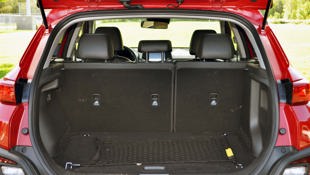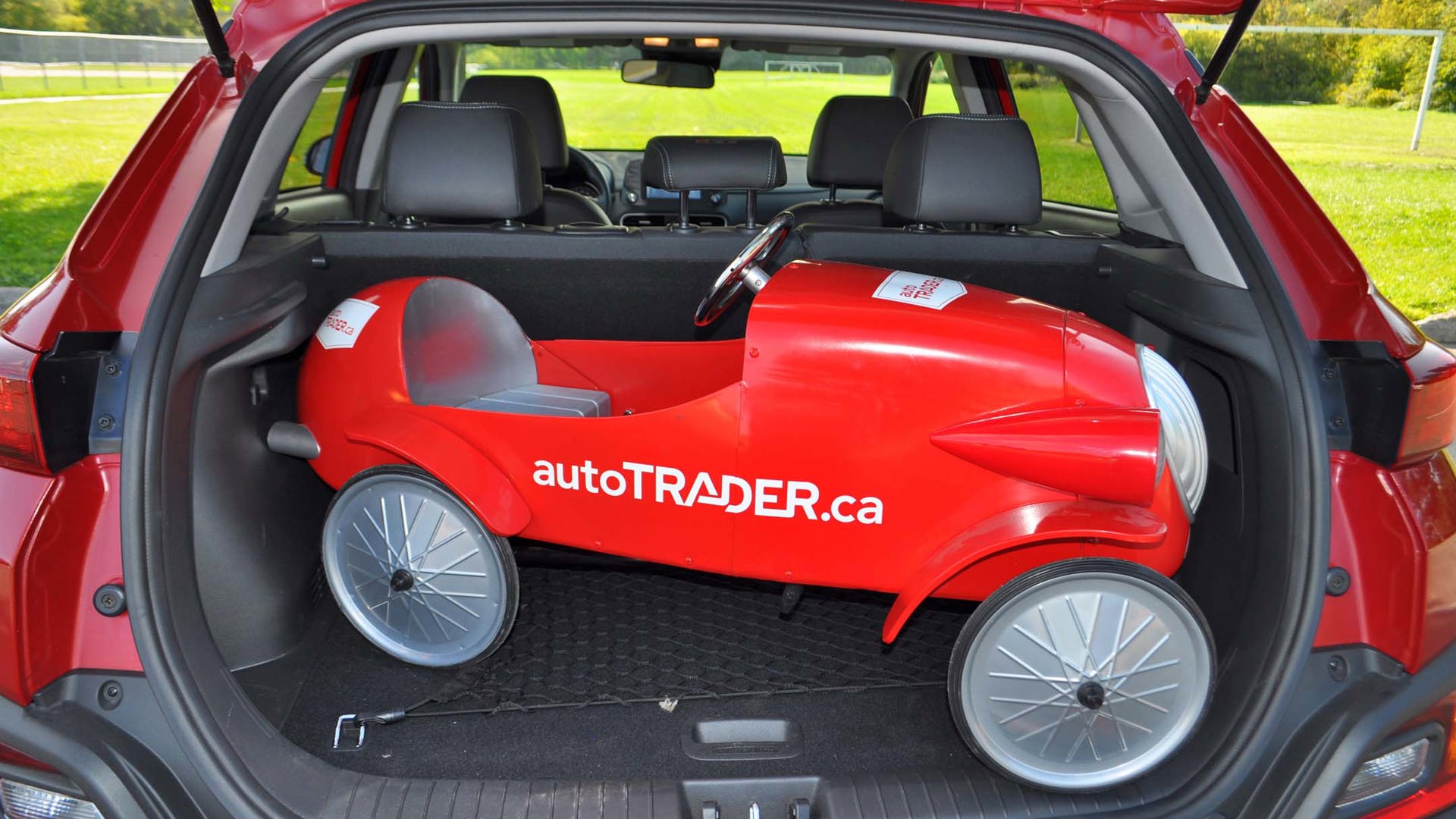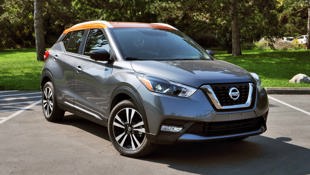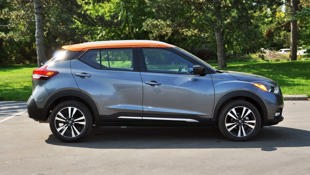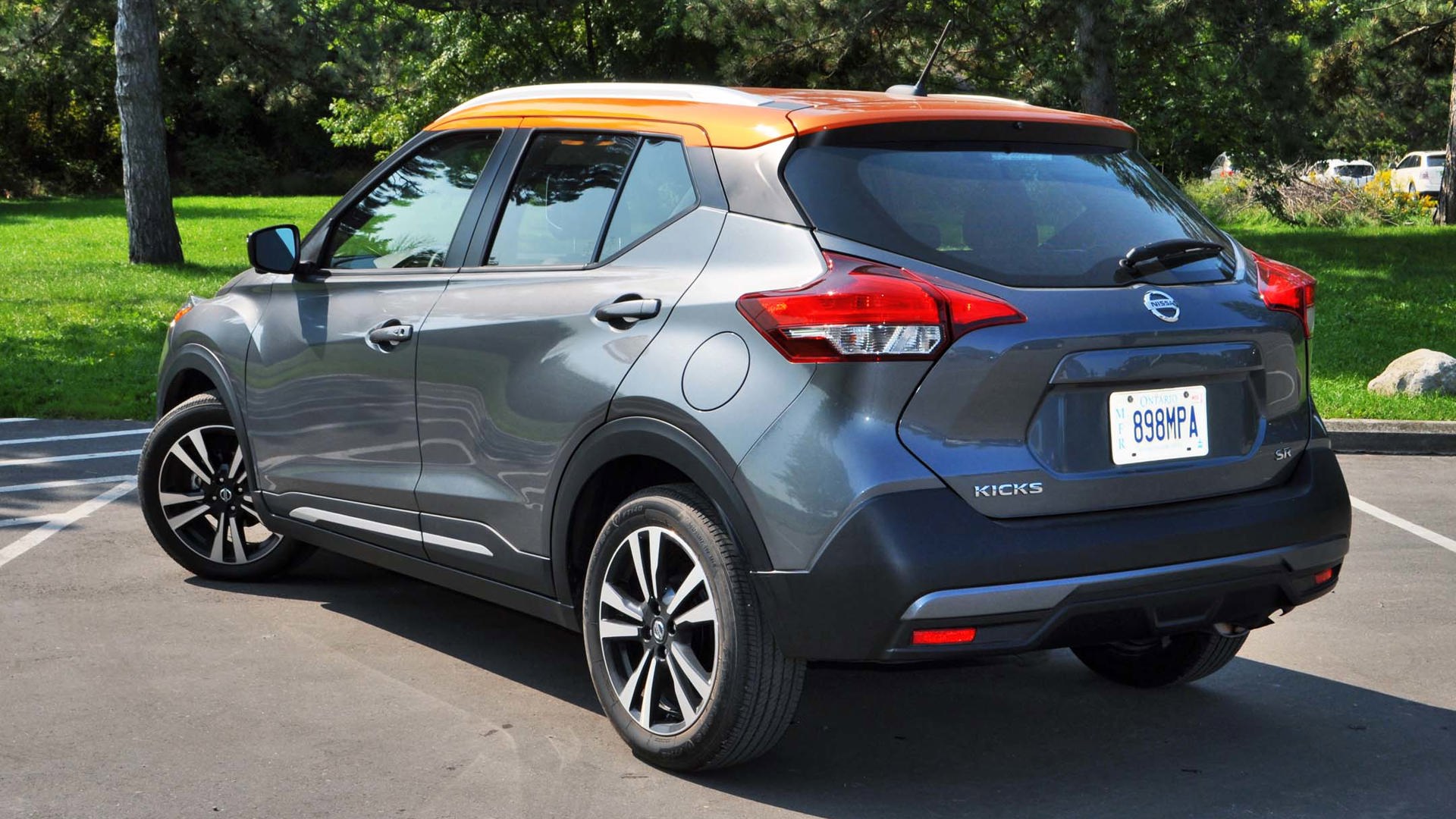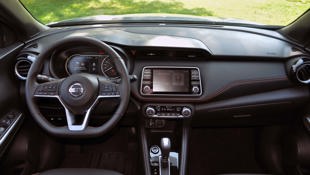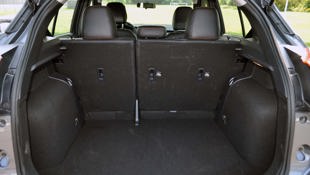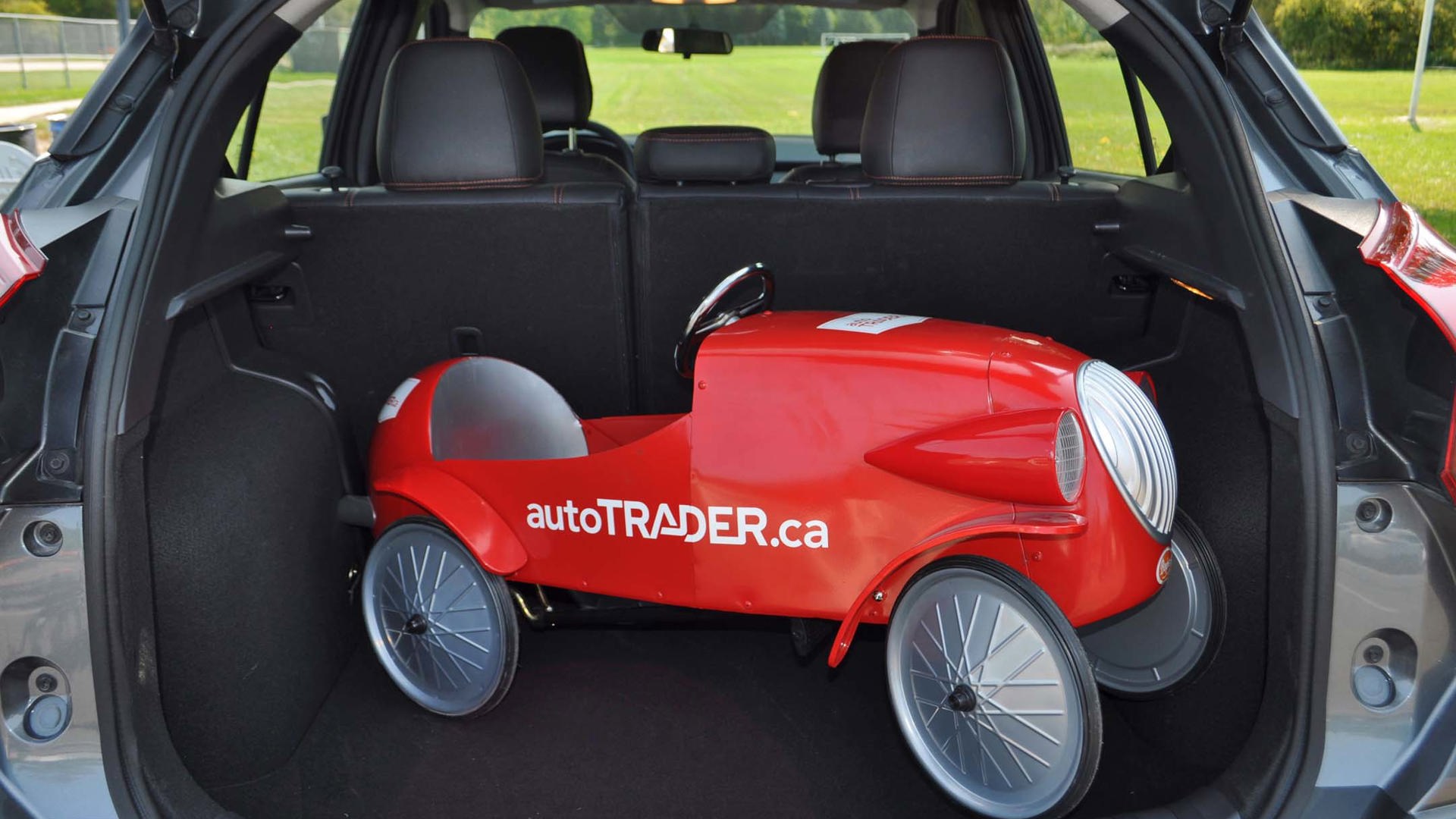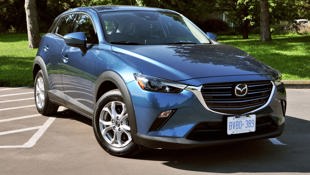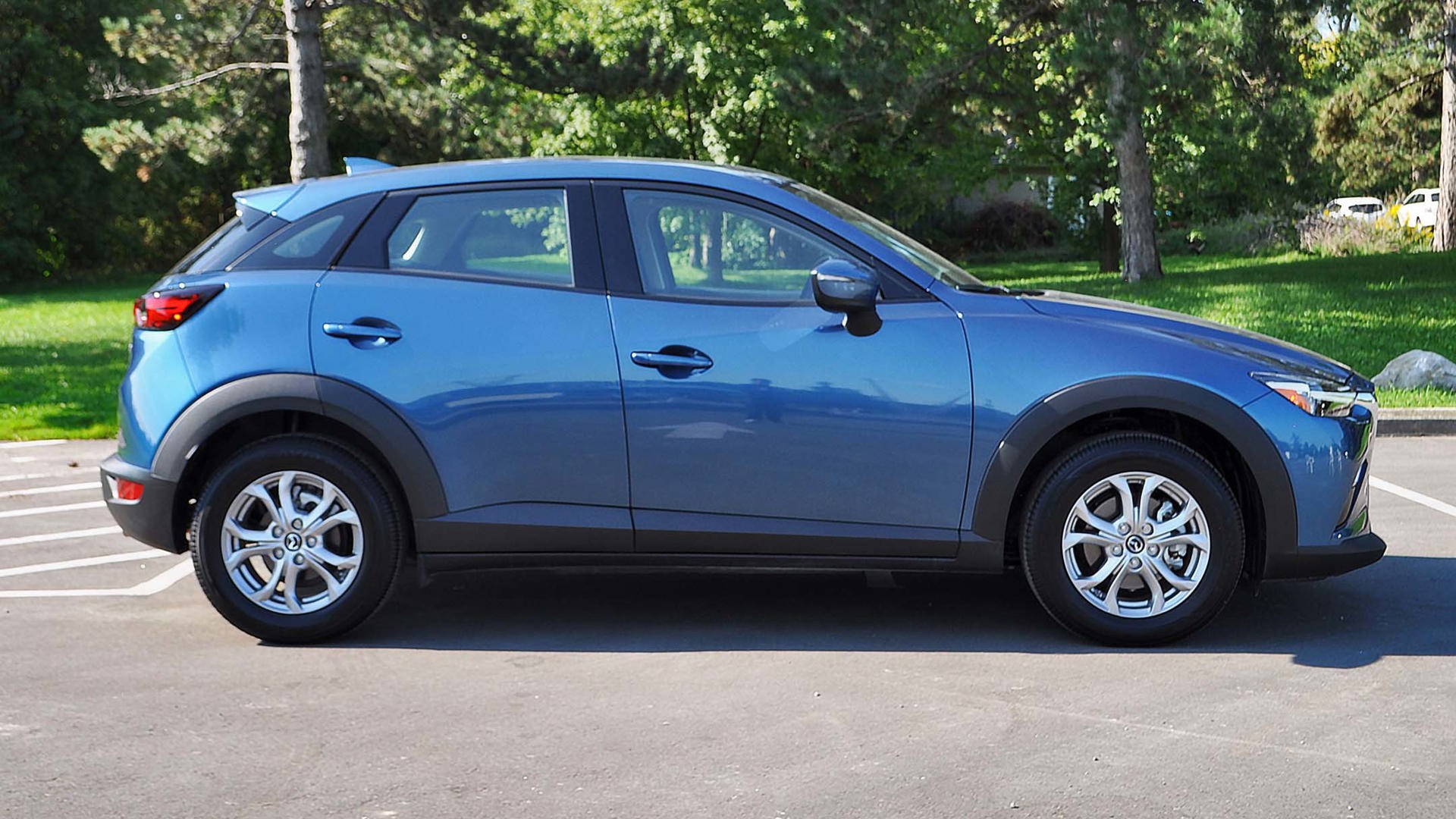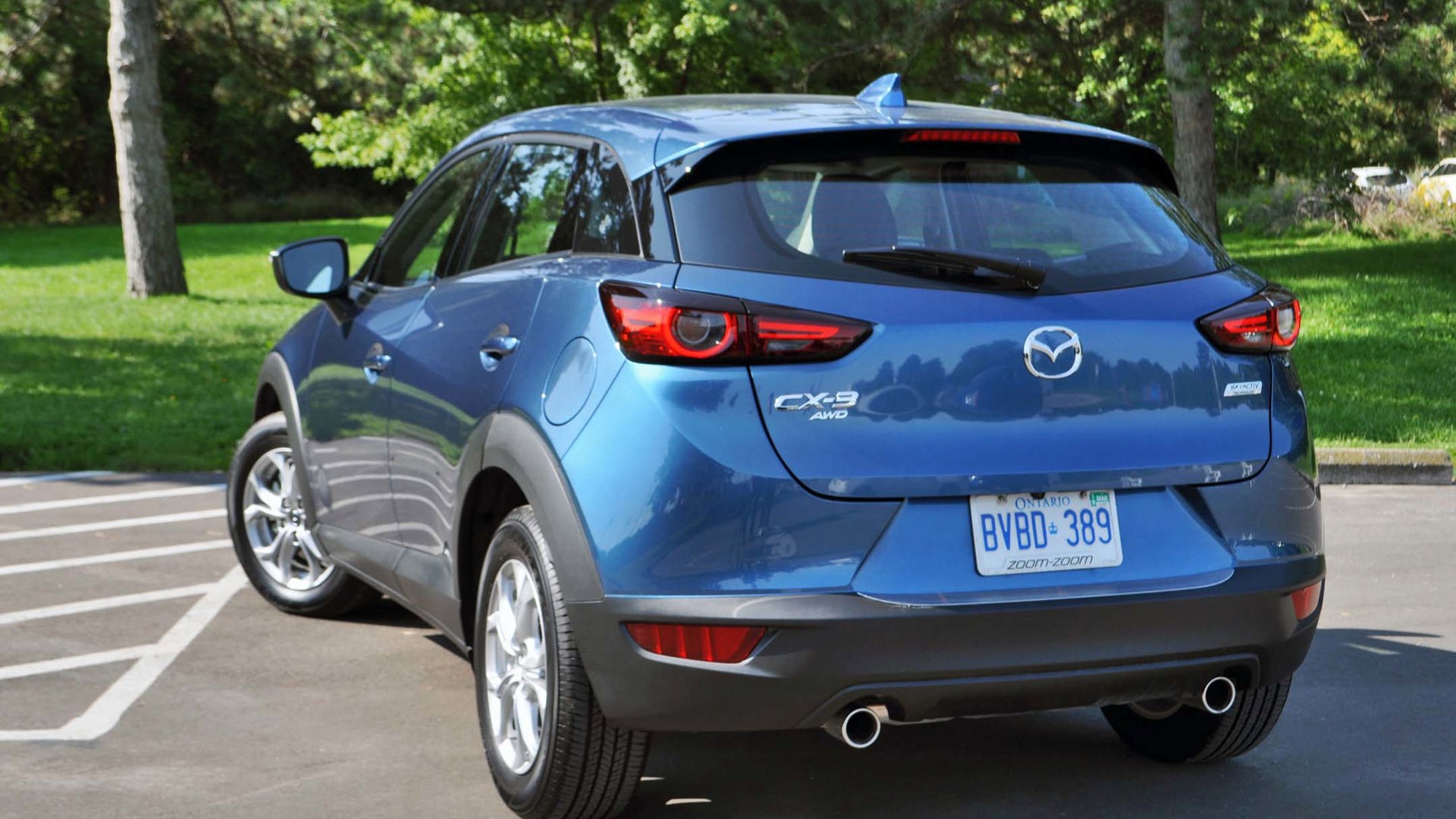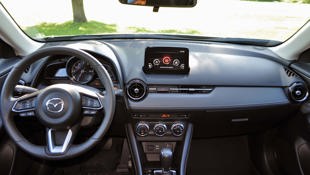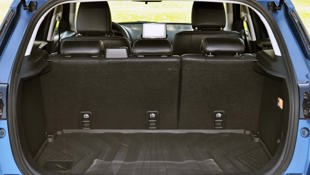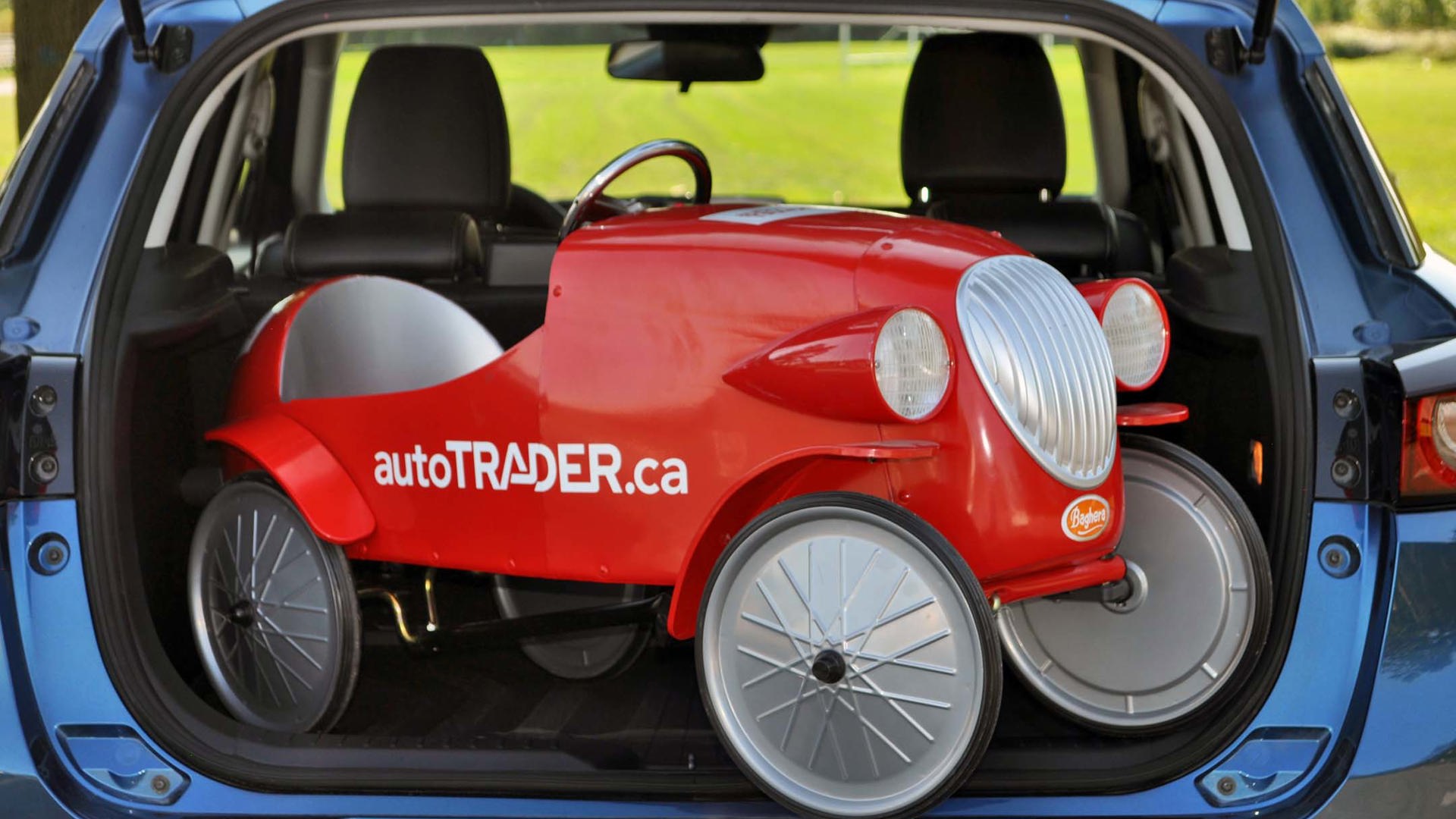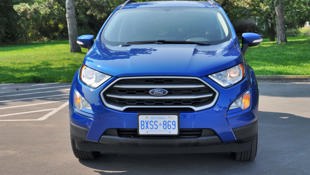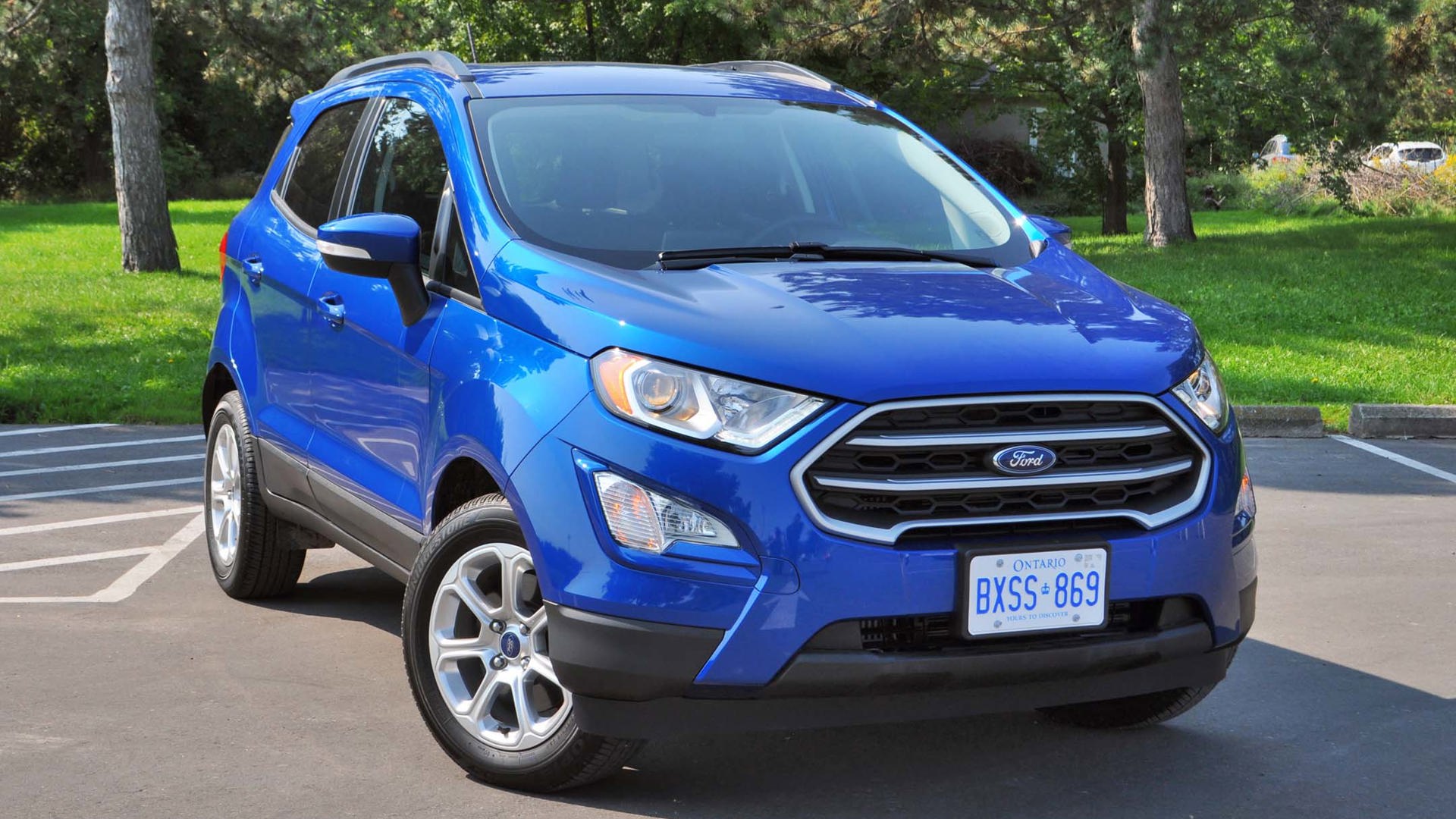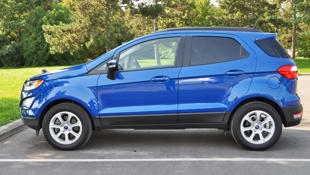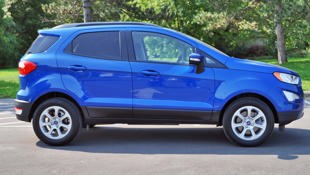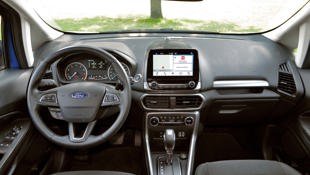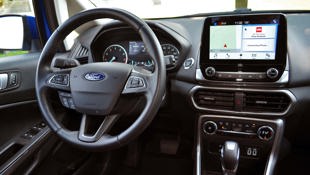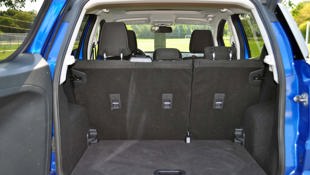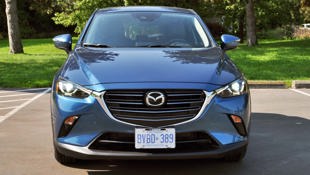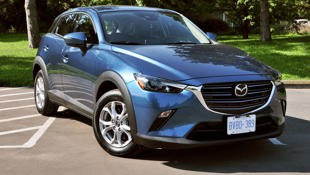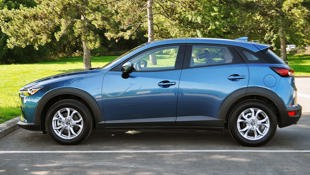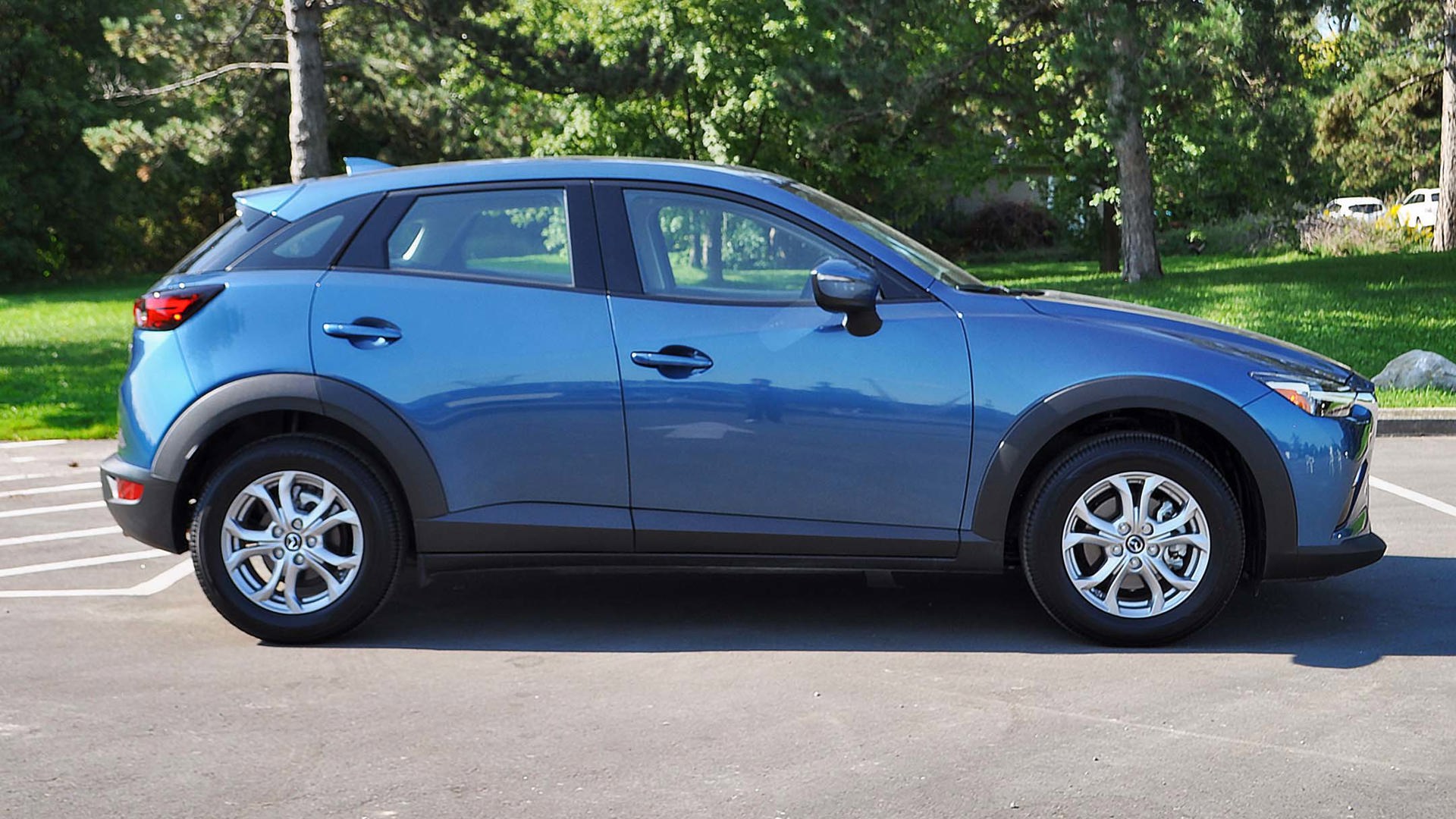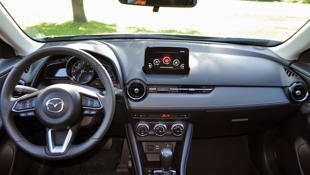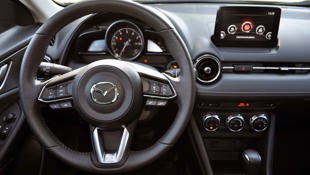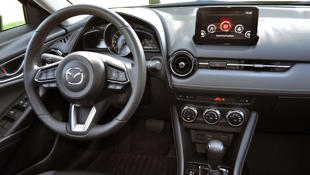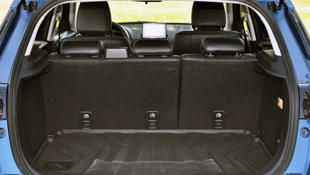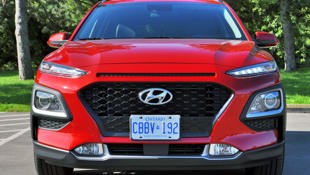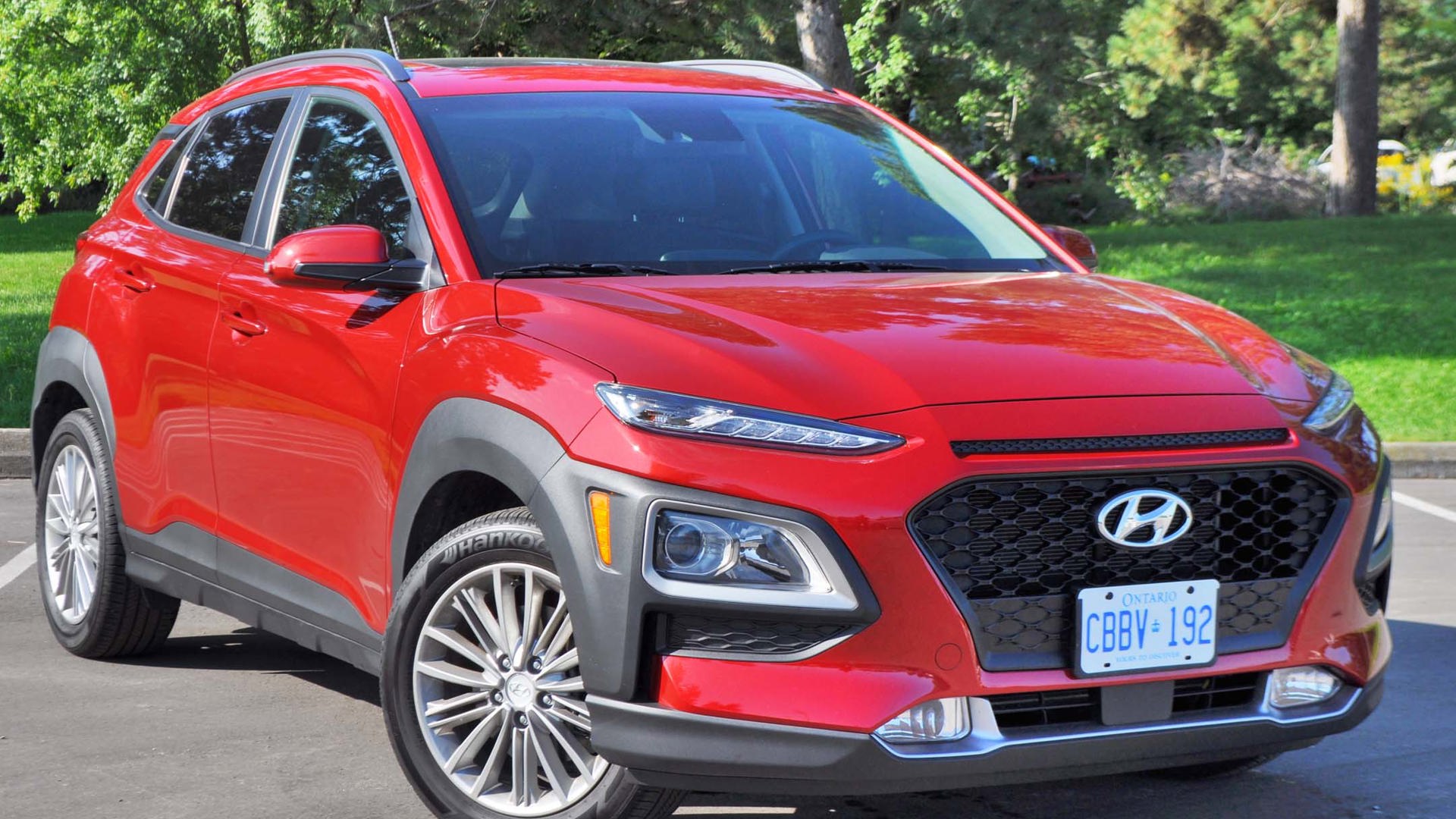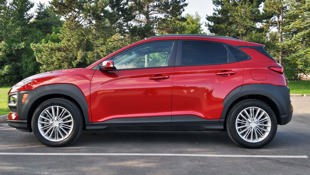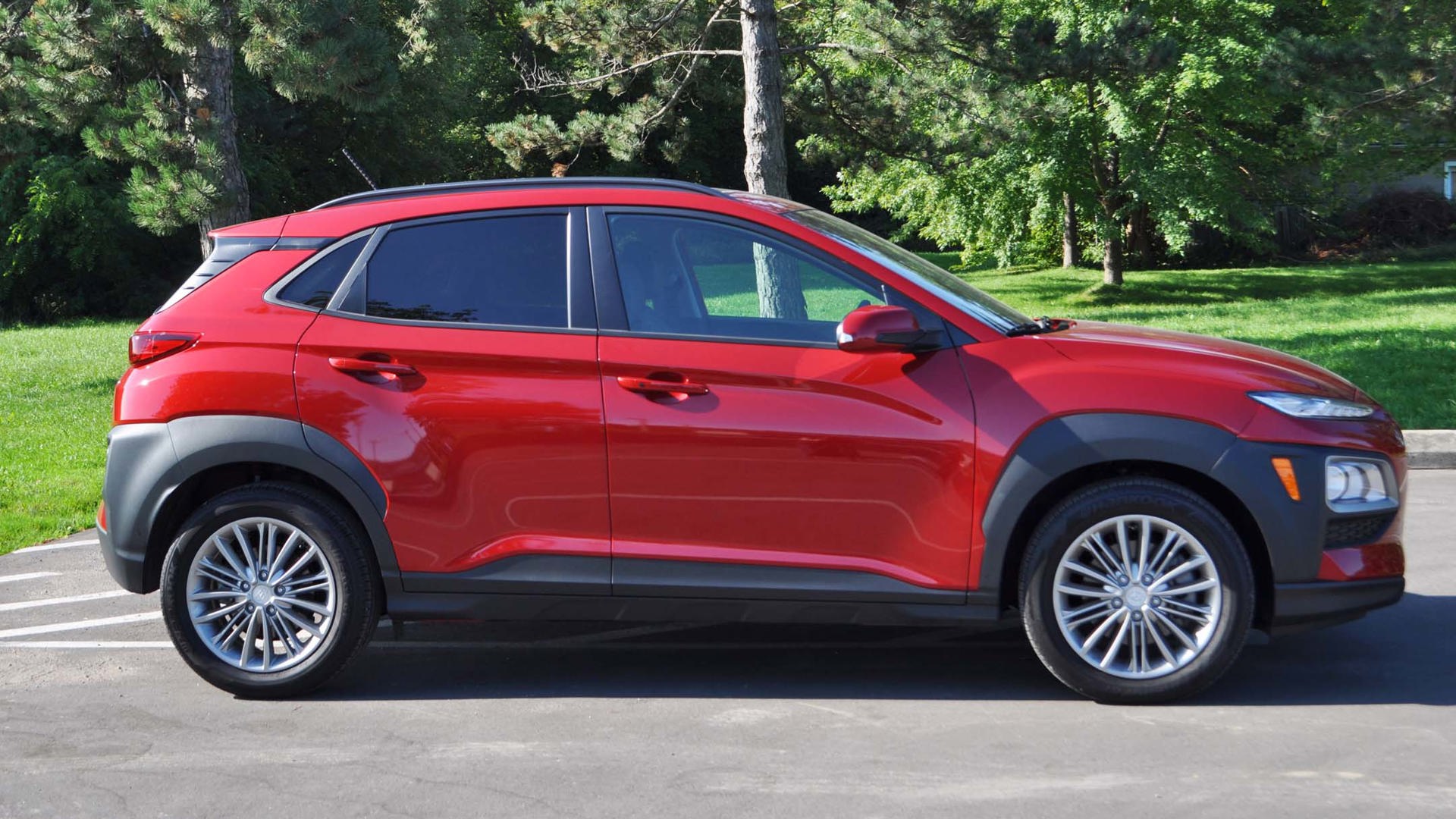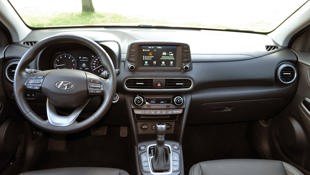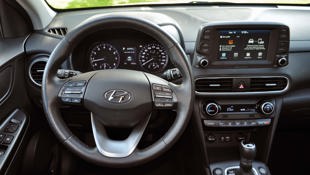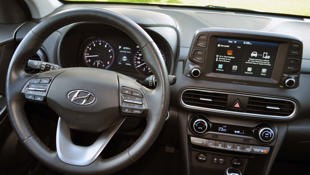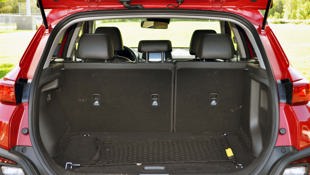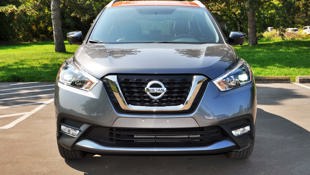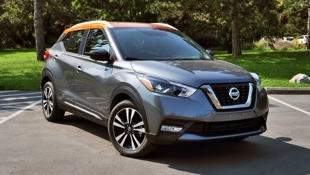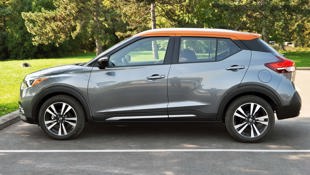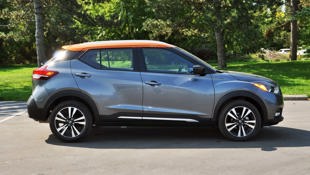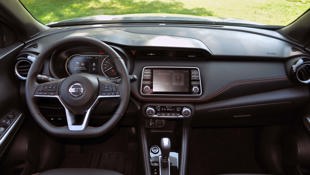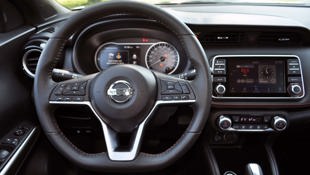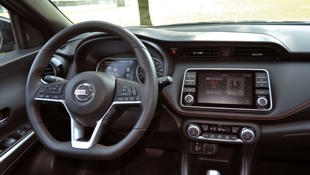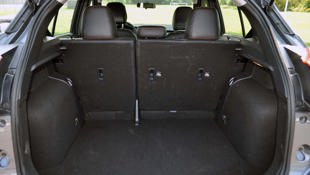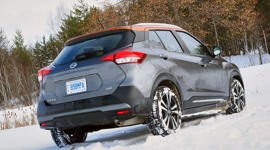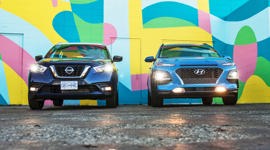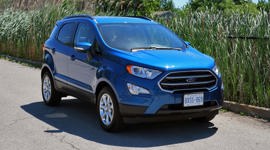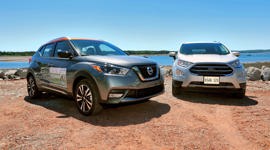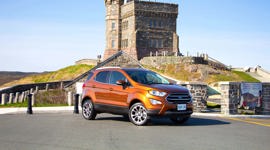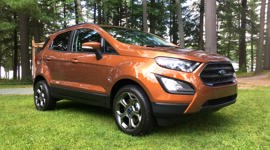Comparison Data
|
2018 Ford EcoSport SE FWD
|
2018 Hyundai Kona Luxury AWD AT
|
2018 Nissan Kicks 1.6 SR CVT
|
2019 Mazda CX-3 GS AWD
|
|---|---|---|---|
|
Engine Displacement
1.0L
|
2.0L
|
1.6L
|
2.0L
|
|
Engine Cylinders
I3
|
I4
|
I4
|
I4
|
|
Peak Horsepower
123 hp @ 6,000 rpm
|
147 hp @ 6,200 rpm
|
125 hp @ 5,800 rpm
|
148 hp @ 6,000 rpm
|
|
Peak Torque
125 lb-ft @ 3,500 rpm
|
132 lb-ft @ 4,500 rpm
|
115 lb-ft @ 4,000 rpm
|
146 lb-ft @ 2,800 rpm
|
|
Fuel Economy
8.6/8.1/8.4 L/100 km cty/hwy/cmb
|
9.5/7.8/8.6 L/100 km cty/hwy/cmb
|
7.7/6.6/7.2 L/100 km cty/hwy/cmb
|
8.6/7.4/8.1 L/100 km cty/hwy/cmb
|
|
Cargo Space
592 / 1,416 L seats down
|
544 / 1,296 L seats down
|
716 / 915 L seats down
|
452 / 1,528 L seats down
|
|
Base Price
$24,999
|
$27,499
|
$22,798
|
$23,095
|
|
A/C Tax
$100
|
$100
|
$100
|
$100
|
|
Destination Fee
$1,790
|
$1,805
|
$1,795
|
$1,895
|
|
Price as Tested
$28,639
|
$29,404
|
$24,978
|
$30,190
|
|
Optional Equipment
$1,750 – SE Convenience Package $1,750
|
None
|
$285 – Two-Tone Metallic Paint $285
|
$5,100 – i-Activ AWD $2,000; Luxury Package $1,500; i-Activsense Package $1,600
|
What do you get when you call back a past autoTRADER.ca comparison test multiple-time podium finisher and pit it head to head against three of the newest and hottest competitors in its segment?
The results may surprise you… they certainly weren’t what any of us were expecting.
One big-time throwdown of tiny SUVs, that’s what.
The subcompact crossover segment is exploding here in Canada, and automakers, naturally, all want their piece of that expanding pie. That means we’ve seen an influx of cute-utes into our market, some new and others new-to-us, as brands attempt to appeal to our ever-upsizing desire to downsize.
And so, here we take the Mazda CX-3 – already a perennial favourite of autoTRADER.ca contributors, it gets a slight power bump and retuned suspension among other light updates for 2019 – and pit it against three of its emerging challengers: the Ford EcoSport, Hyundai Kona, and Nissan Kicks.
Two other sales leaders in this segment, the Honda HR-V and Toyota C-HR, were not available for this evaluation, but it’s worth noting that both finished behind the CX-3 in previous autoTRADER.ca comparison tests.
As for the four vehicles in front of us here: the results may surprise you. Going in, they certainly weren’t what any of us were expecting.
A Note On Scoring
We approach these tests with a set of 30–40 touch points for our reviewers to score each car on. Interior, for example, includes cargo space, and feature content. Design is the aesthetics of the vehicle. Seating is seat comfort, leg room, headroom, and ergonomics. We try to weight these sectors according to the comparison test. In this instance, we weighted them:
- Design: 15 percent
- Seating: 15 percent
- Interior: 30 percent
- Suspension/Chassis: 15 percent
- Powertrain: 7.5 percent
- Fuel Economy: 7.5 percent
- Value: 10 percent
Each of the cars was then given a simplified score out of 10, that determined their final rankings. The scores are:
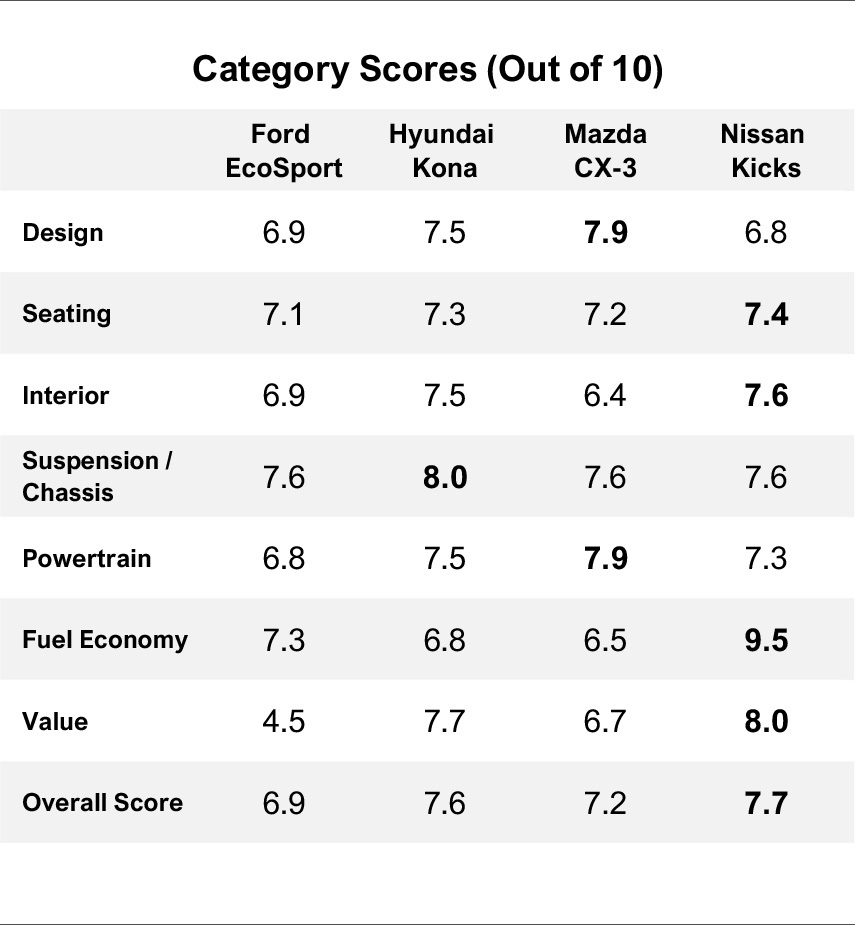
Fourth Place: 2018 Ford EcoSport
Stephanie Wallcraft
It’s the tiniest crossover that can be bought in Canada, and that fact alone could very well win certain buyers over.
But it wasn’t enough to win over our reviewers, who got hung up on the quirky, side-opening rear hatch and the performance of the powertrain. That out-from-the-curb rear opening is cute and unique, and is a side effect of the optional rear-mounted spare tire available on the base model, but it doubles the clearance you need from rearward obstacles to get the door open all the way.
“Its three-cylinder engine actually holds up decently on the power front,” says Michael Bettencourt, Managing Editor at autoTRADER.ca. The EcoSport’s 1.0-litre EcoBoost engine – that’s “Echo”-Sport with “Eeco”-Boost according to Ford, by the way, which is all a little confusing – rates at 123 hp and 125 lb-ft of torque. “But it falls over on refinement, especially of the six-speed automatic transmission – you’d swear it was an early-generation CVT by the seeming disconnect of the revs and accelerator.”
It also, despite its diminutive displacement, wasn’t our best real-world performer in fuel economy. The EcoSport sat at 8.3 L/100 km at the end of our testing day, which was good enough for second-best.
And while it’s fairly compliant over rough roads and settles down quickly over bumps, its tall and narrow body style leaves it prone to noticeable body roll in tight cornering.
These traits and others speak to the fact that while this car is new to us, on a grander scale it’s not actually all that new. This is the second-generation EcoSport that has been available in some global markets since the 2013 model year.
“It feels like the cheapest of the bunch upon getting in, as the only one with full cloth seats,” Bettencourt says. “But it does have some surprisingly high-end features, such as the 110V outlet in the rear, illuminated twin USBs up front, and it’s the only one that comes with a navigation system.”
Families should note that while the middle position isn’t a problem, the outboard rear seats are more narrow than average and may be too narrow for some car seat designs. If you plan to use two, be sure to test both of them in the car before buying.
Where this EcoSport tester lost us most is that, while its feature content is otherwise respectable with a highly usable touchscreen-driven Sync 3 infotainment system with Android Auto and Apple CarPlay, it gets all the way to its $28,639 as-tested price without having a heated steering wheel – “a cardinal sin for any new car in Canadian winter,” Bettencourt says. Made worse, arguably, without all-wheel drive. It’s optional on the mid-grade SE and on this Titanium trim, but only with the 2.0-litre engine and for $1,723 more.
“The Ford marketing types must be Kicks-ing themselves for this pricing strategy,” autoTRADER.ca contributor Peter Bleakney says. “It’s just too much money for a dated crossover with too many issues.”
Third Place: 2019 Mazda CX-3
Michael Bettencourt
The sophisticate of the bunch, but also the costliest – if these high-riding hatchbacks (let’s call a spade a spade here) were college students, the Mazda CX-3 would be the popular trust-fund senior who likes to party, with svelte looks inside and out, well-damped body motions, luxury-level interior features, and an overall driver-focussed feel.
Our testers all heaped praise on its looks, both inside and out, with the highest scores in our group for exterior and interior design, as well as interior quality – call it the most Germanic of this non-German quartet.
First impressions upon climbing aboard, however, were not quite so sophisticated, as it was the only one of the bunch that required you to actually hunt around in your pocket or purse for the key fob to unlock it, which is a pain when you walk up to it with your hands full. There were also some missing features inside, not surprising given that this was not a fully loaded CX-3, but some were particularly glaring. For example, despite the hard Navi button near the upscale central controller between the seats, as well as its prominence on the home menu, the optional navi system was not only missing, but the layout provided constant reminders of its absence.
“The priciest car on our list earns its place with upscale materials and properly comfortable seats with a bit of side bolstering – although they’re manual, which is a surprise at this price point,” noted contributor Stephanie Wallcraft of the CX-3 sales heavyweight.
It’s not like the CX-3 was grossly pricier than the others here either. This particular mid-level GS topped out at an as tested price of $30,190, which was within a few hundred dollars to the Kona, and a couple thousand higher than the Ford EcoSport. That’s notably higher than the value-laden Nissan Kicks’ $24,978 as-tested sticker, but it does include all-wheel drive, a head-up display, and an automatic high-beam system that are all unavailable in the Kicks.
While the quality interior materials and rare features in this class help impart the CX-3’s refined feel, with such niceties as a heated steering wheel and convincing leatherette, this is a machine that’s meant to convey joy while driving. Its shift paddles are a clear sign that it’s ready for driving fun whenever called upon, whether that’s on a juicy onramp or on a twisty road. Unfortunately, there’s a ride penalty for its relatively flat and hot-hatch-like handling, as well as practicality compromises for its swoopy styling in both the back seat and cargo area.
“Very cramped in the back with difficult ingress/egress, and despite claimed improvements to NVH and suspension tuning for 2018, this one still showed the flintiest and noisiest ride,” said Peter Bleakney, who absolutely loved the shift paddles, and missed them on the others.
Indeed, it was these less emotional and more practical aspects where the CX-3 often fell short. Sure, its 148 hp and 146 lb-ft of torque especially was the highest of the group, but it didn’t notably separate itself power-wise on the road from the others, and its observed fuel consumption of 8.9 L/100 km also came in third, just a tenth ahead of the newer Kona.
“The load floor is high and cargo area is small, which could be a turn-off for some buyers,” noted Stephanie, the mom in our group of dads. “Really not a fan of the single floppy cup holder in the centre console either.”
So despite the praise for its interior design, the CX-3 actually scored lowest for its interior overall, once roominess, flexibility, and cabin storage were taken into account. And of course, when you’re talking the majority of small crossover buyers, these aspects rank high in priority.
Yes, there were pockets of praise here too, specifically for the generous visibility out the rear-view mirror helped by the rear headrests that could be moved low and out of the way; and the sound quality of the stereo, though some found it too menu-heavy and needed too much controller-twirling at times.
Plus it offered a worthy slate of advanced safety features as well, most of them as part of the $1,600 i-Activesense package, such as active cruise control that slows you down automatically when highway traffic slows ahead (and accelerates you back up to speed when traffic clears up), pedestrian detection, rain-sensing wipers, rear cross-traffic alert, and auto-levelling headlights.
Second Place: 2018 Hyundai Kona
Peter Bleakney
Snagging second spot in this tight battle was another fresh entrant in the subcompact crossover segment – the 2018 Hyundai Kona. Consider this offering from the fast-moving Korean automaker to be the yin to the lightweight and perky Nissan Kicks’ yang.
At 1,478 kg, it’s a full 263 kg portlier, and here we get all-wheel drive, the best ride comfort and noise suppression of the group, and a general sense of grown-up solidness. It’s also reasonably athletic too, with decent body control, although not nearly as fun to flick around as the Mazda CX-3. Stephanie commented “I was left wishing the Kona had a more responsive throttle and more engaging low-speed steering. Once it gets going, though, it’s peppy and fun.”
Michael said, “It’s the flashy athlete that’s new in town, but has the looks to become instantly popular.” We all loved the Kona’s handsome, nicely resolved styling, with the exception of Stephanie who took exception to the faux air intake just below the hood and the ribbing on the C-pillars.
At $29,582 as tested, our Kona 2.0 Luxury AWD was about $600 cheaper than the Mazda CX-3. In true Hyundai fashion, it was nicely equipped, although the Mazda did trump it in feature count. Still, we get 17-inch alloys, heated steering wheel, sunroof, Apple CarPlay, Android Auto, real leather, power driver’s seat with lumbar, blind spot warning, lane-change assist, and rear cross-traffic alert.
The Luxury trim also benefits from Hyundai’s SmartSense active safety suite that includes front collision mitigation, driver attention assist, lane-departure warning, and lane-keep assist – the latter offering up the cool party trick of a few seconds “self steering” if the camera picks up the lane markings and the bend is gradual. Whoopee. No adaptive cruise control here, despite SmartSense including it with other Hyundai vehicles.
Power comes from a naturally aspirated 2.0 Atkinson-cycle four-cylinder that generates 147 horsepower and 132 lb-ft of torque. Power gets to all four tires through a smooth shifting six-speed auto. Acceleration is just adequate, although when pressing on, the four banger gets coarse and thrashy. The Kona is also available with Hyundai’s excellent 175 hp, 195 lb-ft 1.6L turbo four, which we expect will transform this into the class hot-rod. Look for a future test.
The AWD system has a couple of nice features: hill-descent control and the ability to lock the torque split at 50/50 front/rear for better traction on slippery surfaces.
The Kona’s interior may be second to the Mazda’s for design, fit, and finish; but it does shine when it comes to ergonomics. This Korean automaker consistently shows logically arrayed, well marked, and easy-to-decipher controls. And we thank them. Apple CarPlay and Android Auto are supported, and the audio system is good too, although I give the nod to the Mazda for the best in this group.
While not quite as accommodating as the Kicks’, back-seat space in the Kona is good for the class, and the flat load floor when the 60/40 seats are folded is a revelation.
Hyundai knows the subcompact crossover segment is a fresh frontier, and the Kona is poised for battle. Coming soon is a Kona EV that, with its Tesla Model S baiting range, will surely move the electric car game forward.
Winner: 2018 Nissan Kicks
Peter Bleakney
Newest to the Canadian market within this Lilliputian assemblage is the front-drive-only Nissan Kicks. It starts at a heartwarming $17,998 with the base S, stretching to $20,898 for the SV, and $22,798 for this SR. As-tested at $24,978, our Gun Metal Kicks SR with Monarch Orange roof undercut the next cheapest crossover here (and only other front-driver), the Ford EcoSport by a not insubstantial $3,661. That buys a lot of skate boards, beard wax, organic kale, or whatever else the intended demo of this cheerful ute tends to purchase. What they won’t be buying is a lot of is gas.
The Kicks was the champ in our real-world fuel economy evaluation, besting the second-place Ford by a substantial margin.
But the Kicks did not win this comparison on price and fuel economy alone. We liked its peppy exuberance, decent handling, and ride compliance. Stephanie Wallcraft noted, “It’s not screamingly powerful, but it’s agile and makes popping around through city traffic a breeze.” On paper, the Kick’s 1.6L four-cylinder that makes 125 horsepower and a relatively wimpy 115 lb-ft of torque might not look like much, but this ute’s secret weapon is its featherweight 1,215 kg curb weight. That’s 140 kg less than the next heaviest Mazda CX-3.
The Kicks only comes with a CVT (continuously variable transmission), a technology to which Nissan is thoroughly committed. And they arguably make the best in the business. Programmed “steps” mimic real gears, and engine drone only rears its head when you’re really matting the throttle. It’s a smooth four-cylinder too, not thrashy in the upper reaches.
This top-trim Kicks SR surprises with features like 360-degree surround-view camera, handsfree text assistant, three USB ports, cruise control, remote start, and heated mirrors.
Of course, styling is completely subjective, and while the Kicks does not show the elegant lines of the Mazda CX-3, its funky exterior matches the crossover’s personality. The Kicks’ interior also received high marks from our team. We liked the comfortable and supportive seats, leatherette surfaces with orange stitching and the configurable screen to the left of the speedometer that shifts from being a tachometer to showing fuel efficiency readings, local radio, and satellite stations. And you can keep it in whichever mode you choose.
Michael gave the cabin big bonus comfort points for its minivan-style folding centre armrest. The infotainment supports Apple CarPlay and Android Auto, and the Bose audio features groovy little speakers in the driver’s headrest. The only giveaway to the Kick’s bargain price point are the flimsy plastic door panels.
We voted rear seat access and room best in the group, and as Stephanie put it, “Nissan pulled off some Tardis magic by stuffing in the biggest cargo hold of this bunch.” With the split rear seats folded, however, it is not a flat load floor.
The Kick’s only real potential drawback is the unavailability of AWD. This could very well be a deal breaker for some Canadian shoppers, but the fact that it doesn’t offer AWD is the reason for much of the Kicks’ winning attributes: light weight, exceptional fuel economy, zippy handling, large cargo hold, and lower price. In this throwdown, that combo is hard to beat.
